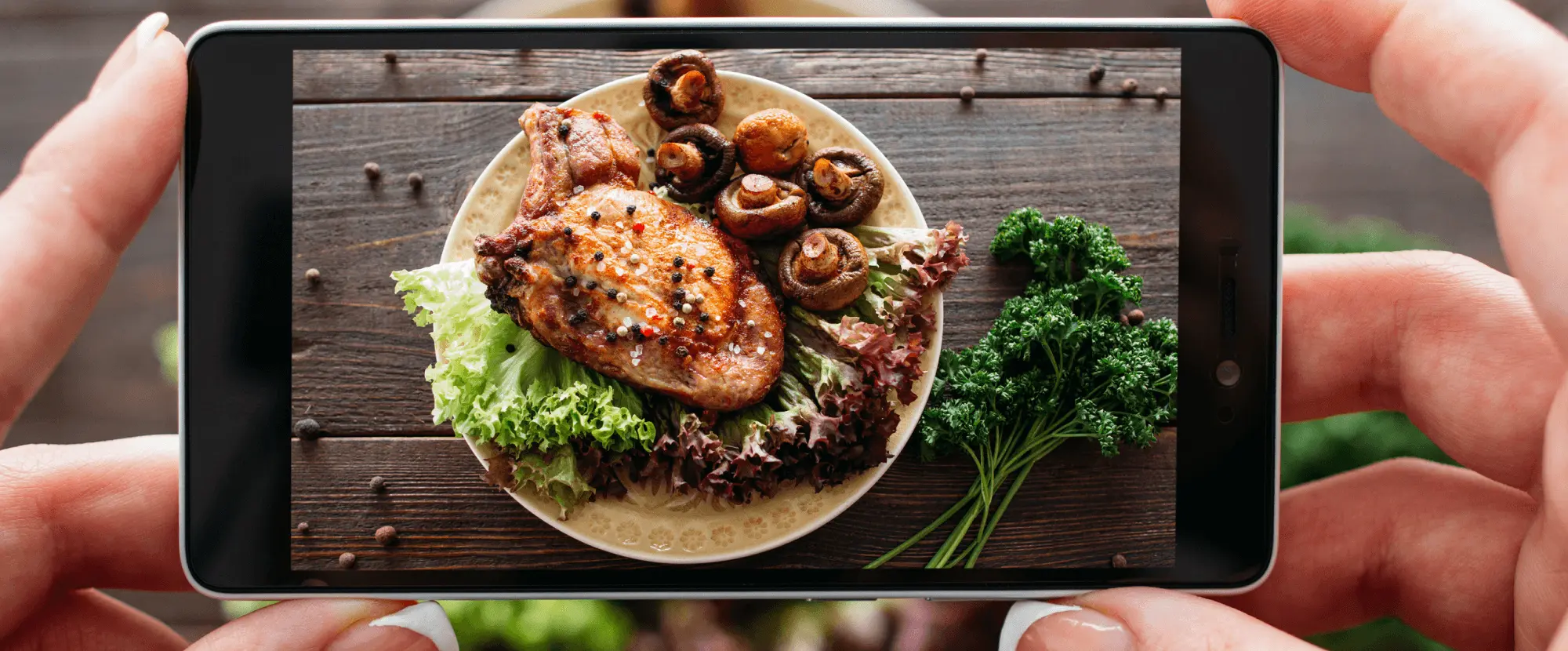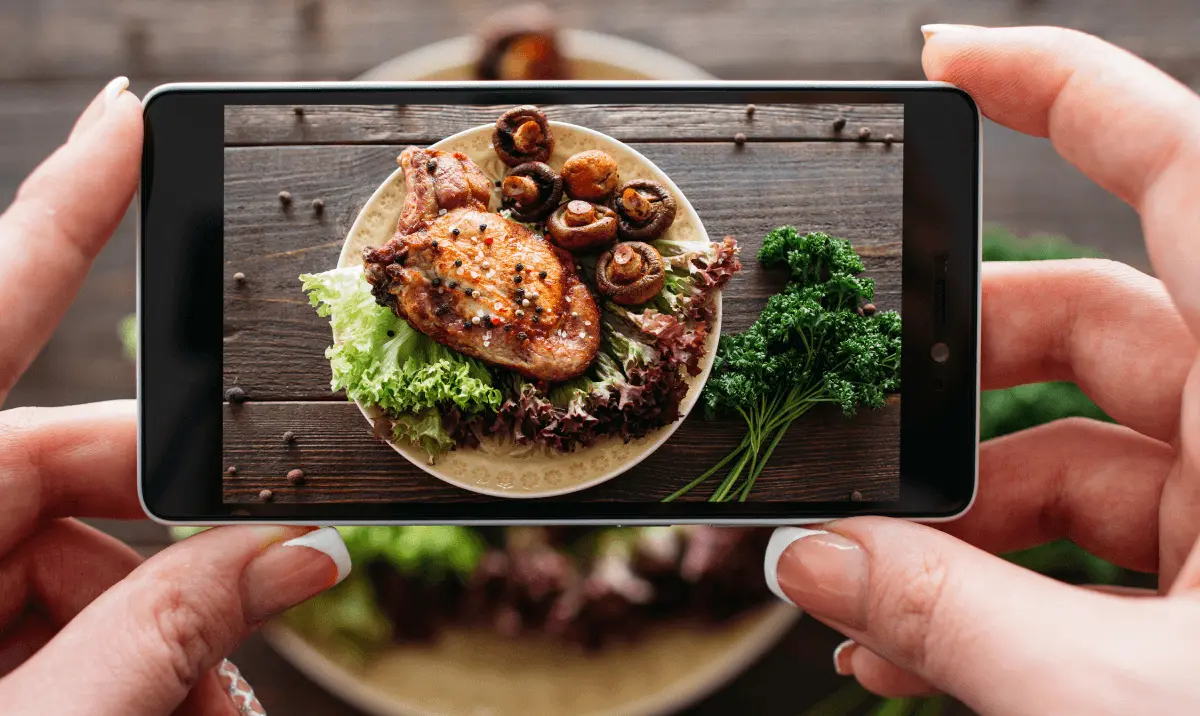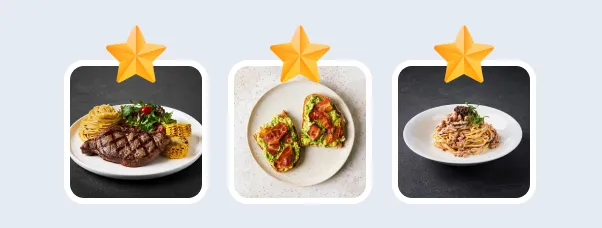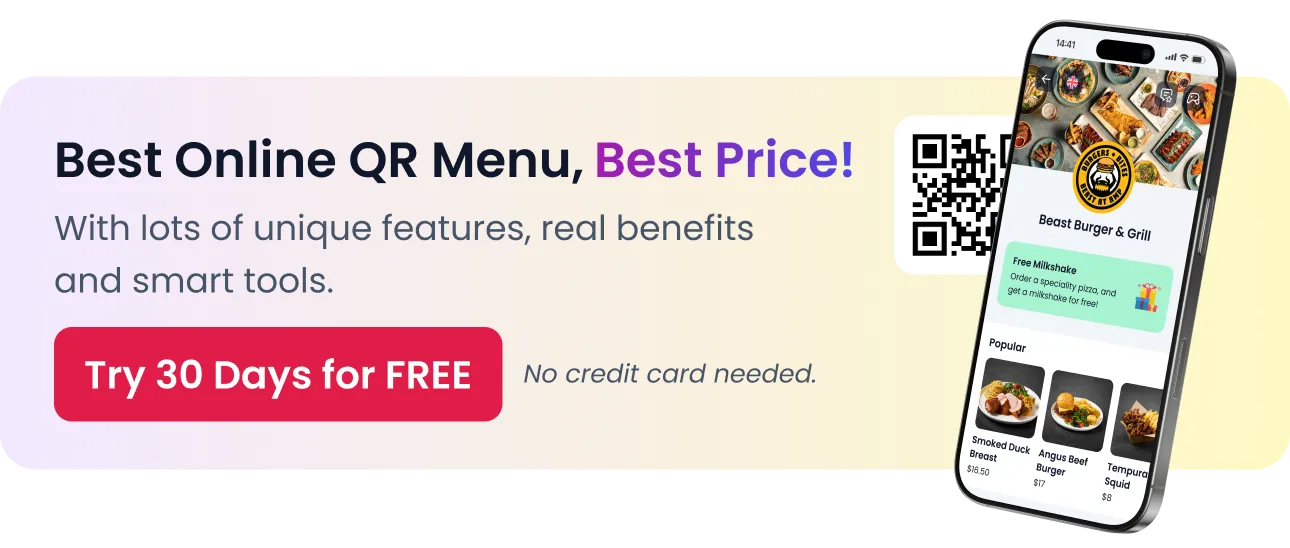

Why Online Menu Photos Are So Important?
In today’s digital age, the way a restaurant presents its menu online can make or break its success. With more customers browsing restaurant offerings via websites, social media, and food delivery platforms, the importance of online menu photos has skyrocketed. These images are often the first impression a potential customer gets, and as the saying goes, “we eat with our eyes first.” A well-crafted photo can entice a diner, while a poorly taken or absent photo can turn them away.
High-quality menu photos don’t just capture the food; they capture the essence of your brand. They convey taste, texture, and even emotion, helping to establish trust and excitement. In fact, studies show that customers are more likely to order a dish when they see a mouth-watering photo compared to just reading a description. Whether it’s the golden crisp of a perfectly fried dish or the rich creaminess of a dessert, photos can elevate a diner’s expectations and influence their choices.
However, the impact of online menu photos goes beyond customer persuasion. These images play a significant role in SEO, social media marketing, and even boosting conversion rates on third-party apps like Uber Eats or DoorDash. Restaurant owners who invest time and effort into crafting stunning visuals often find that the benefits—both in customer engagement and sales—are well worth the investment.
What Makes a Great Online Menu Photo?
A great online menu photo does more than just show the food; it tells a story, evokes an emotional response, and builds anticipation. To capture the perfect image, restaurant owners need to consider several key factors that go into creating visually appealing and accurate representations of their dishes. From image quality to lighting and consistency, let’s explore what sets a standout menu photo apart from an ordinary one.
Definition of a High-Quality Menu Photo
For a photo to be truly effective, it needs to meet certain technical standards. High-quality images are not just pleasing to the eye; they also instill confidence in potential customers. Here’s what defines a top-notch menu photo:
- High resolution: Ensure the photo is clear and sharp, without any pixelation.
- Proper lighting: Avoid harsh shadows or overly dark areas. Natural lighting or well-balanced artificial lighting works best.
- Composition: Arrange the food in an aesthetically pleasing manner, ensuring it’s the focal point of the image.
- Accurate color representation: The colors in the image should match the actual dish to avoid customer disappointment.
These elements together create an inviting photo that both looks professional and captures the dish in its best light.
The Role of Visual Appeal in Food Presentation
Visual appeal is one of the most critical factors in a successful menu photo. It’s not just about showing what the dish looks like—it’s about making it look irresistible. When customers see a photo of a dish that looks delicious, they are more likely to crave it and place an order. Key aspects of visual appeal include:
- Highlighting textures: Crispy, creamy, juicy—bring out the textures to evoke the senses.
- Color contrast: Vibrant, contrasting colors (such as bright greens next to golden-brown crusts) can make a dish pop.
- Angles and focus: Shoot from angles that emphasize the depth of the dish, with a clear focus on its most appealing aspects.
When done right, these techniques help create an image that triggers appetite and desire.
Why Consistency Across All Images Matters
Consistency is often overlooked but plays a vital role in how your menu photos are perceived. A consistent style across all images not only looks professional but also strengthens brand identity. Here’s why consistency is key:
- Branding: Consistent lighting, angles, and styling help reinforce your restaurant’s identity.
- Customer trust: When every dish is photographed similarly, customers know what to expect, building trust in your offerings.
- Seamless experience: Whether on your website, social media, or third-party apps, a uniform look ensures a smooth, professional customer experience.
Inconsistent images, on the other hand, can confuse customers and make your menu look less reliable or polished.
How Online Menu Photos Influence Customer Decisions?
In the highly competitive restaurant industry, a well-crafted menu photo can be the difference between a customer choosing your restaurant or moving on to the next option. Visual content significantly impacts how customers perceive your offerings and can directly influence their purchasing behavior. Let’s dive into the psychology behind food photos, how they affect purchasing decisions, and how they shape customer expectations.
The Psychology Behind Food Photos
Humans are inherently visual creatures, and food is no exception. High-quality menu photos can trigger emotional and sensory responses, which can lead to cravings and hunger. This is how it works:
- Visual stimuli: Photos of food activate the brain’s reward system, creating a sense of pleasure and desire.
- Craving activation: Seeing a photo of a juicy burger or a colorful salad can stimulate cravings, even if the customer wasn’t initially hungry.
- Emotional connection: Photos can evoke emotions—comfort, excitement, nostalgia—which further drive the decision to order.
By understanding these psychological triggers, restaurant owners can create menu photos that not only capture attention but also stimulate the desire to eat.
The Impact of Photos on Purchasing Decisions
Menu photos have a direct impact on customer purchasing behavior. A visually appealing photo can nudge customers toward selecting certain dishes, especially those featured prominently. Key ways in which photos affect purchasing decisions include:
- Higher engagement: Customers spend more time looking at menus that include photos, increasing the likelihood of placing an order.
- Increased sales of featured items: Items with attractive photos are more likely to be ordered than those without images.
- Showcasing high-margin dishes: By highlighting profitable menu items with mouth-watering photos, restaurants can strategically boost their bottom line.
When customers are presented with well-crafted photos, they are more confident in their choices, leading to increased satisfaction and sales.
Building Customer Expectations and Delivering on Them
Menu photos play a crucial role in setting customer expectations, and it’s essential that those expectations are met when the food arrives. Here’s why:
- Visual representation of the dish: Accurate photos set the stage for what customers will receive, building trust in your brand.
- Avoiding disappointment: Overly staged or unrealistic photos can lead to disappointment if the food doesn’t match, resulting in negative reviews or complaints.
- Creating consistency: When the photo matches the reality of the dish, it builds a positive experience and repeat business.
By ensuring that menu photos are both enticing and truthful, restaurant owners can build long-term customer loyalty and minimize the risk of dissatisfied diners.
How to Capture High-Quality Menu Photos on a Budget?
Capturing high-quality menu photos doesn’t have to break the bank. While professional photographers can deliver stunning images, there are cost-effective methods restaurant owners can use to create their own mouth-watering visuals. With the right techniques, tools, and a little creativity, you can produce professional-looking photos without hiring an expensive photographer.
DIY Photography Tips for Restaurant Owners
You don’t need a high-end camera to take great food photos—smartphones can often do the trick. Here are some DIY tips to help you get started:
- Natural lighting is key: Take advantage of natural daylight. Position your dishes near a window for soft, even lighting.
- Avoid overhead lighting: Overhead lighting can create harsh shadows. Instead, use side lighting to bring out the textures and details.
- Keep the background simple: A clutter-free background focuses attention on the food. Use neutral tones or minimalist settings to avoid distractions.
- Use props wisely: Incorporate simple props like utensils, napkins, or fresh ingredients to enhance the presentation without overcrowding the image.
- Experiment with angles: Try shooting from various angles—overhead for flat dishes, 45-degree angles for layered dishes—to find the best perspective.
These simple strategies can elevate your menu photos, making them look professional and appealing even on a limited budget.
Hiring a Professional Photographer vs. DIY
While DIY photography is a great option for budget-conscious restaurants, there are times when hiring a professional might be worth the investment. Here’s how to weigh the pros and cons:
- DIY Pros:
- Cost-effective
- Greater flexibility and control over the process
- Immediate access to photos for updating the menu or promotions
- DIY Cons:
- Potential for lower quality if skills or tools are lacking
- Time-consuming
- Hiring a Professional Pros:
- Guaranteed high-quality images
- Access to professional equipment and expertise
- Saves time for restaurant owners
- Hiring a Professional Cons:
- Higher upfront costs
- Scheduling and availability constraints
Consider your budget and the long-term needs of your business before deciding which approach to take.
Essential Tools for Menu Photography
Even with a limited budget, there are a few essential tools that can make a big difference in your menu photography:
- Lighting kits: Affordable LED lighting kits are available that mimic natural light. These are a great investment for restaurants with limited access to daylight.
- Tripod: A small tripod helps stabilize your camera or smartphone, ensuring sharp images without blur.
- Backdrop options: Inexpensive backdrops such as neutral-colored tablecloths or wooden boards can add a professional touch to your photos.
- Editing apps: Apps like Lightroom, Snapseed, or VSCO are free or low-cost options for editing your photos to improve brightness, contrast, and color balance.
With these tools, even novice photographers can create high-quality images that capture the essence of their menu items.
Is Using Stock Photos a Good Idea for Menus?
When it comes to displaying menu items online, some restaurant owners may consider using stock photos as a quick and cost-effective solution. While stock images can be a useful resource, there are important factors to weigh before incorporating them into your menu. Let’s explore the pros and cons of using stock photos, as well as best practices for selecting images that reflect your brand and offerings.
The Pros and Cons of Stock Photos
Stock photos offer a convenient alternative to professional photography, but they come with their own set of advantages and disadvantages. Here’s a breakdown:
- Pros:
- Cost-effective: Stock photos are generally much cheaper than hiring a photographer or setting up a DIY photo shoot.
- Time-saving: You can quickly access a wide range of professionally taken food images that look polished and appetizing.
- High-quality visuals: Most stock photos are shot by professionals, ensuring the images are clear, well-lit, and visually appealing.
- Cons:
- Lack of authenticity: Stock photos don’t accurately represent your restaurant’s dishes, which can lead to customer dissatisfaction when the food doesn’t match the image.
- Overuse of generic images: Many stock photos are widely used by other restaurants, meaning your menu may not stand out or could even seem unoriginal.
- Limited customization: Stock photos may not match your restaurant’s unique style or branding, reducing the overall impact on your target audience.
While stock photos are an easy fix, they may not always provide the authenticity customers expect from an online menu.
Best Practices for Choosing Stock Photos
If you decide to use stock photos, it’s crucial to be selective to avoid misleading your customers and to ensure the images align with your brand. Follow these best practices:
- Match your style and cuisine: Look for photos that closely resemble your actual dishes in terms of portion size, presentation, and ingredients.
- Avoid overly staged or unrealistic images: Opt for images that feel natural and reflect the type of dining experience your restaurant offers.
- Use stock images sparingly: If possible, limit stock photos to menu categories that are hard to photograph, like beverages or generic side dishes. For signature items, try to feature real photos of your own dishes.
By carefully choosing stock photos that fit your brand, you can still maintain a visually attractive menu without misleading customers.
The SEO Benefits of Using Optimized Menu Photos
Optimizing your online menu photos doesn’t just enhance their visual appeal—it can also give your restaurant a valuable boost in search engine rankings. Search engine optimization (SEO) plays a significant role in increasing your restaurant’s visibility on Google and other platforms. By properly optimizing your menu images, you can drive more traffic to your website, improve local search visibility, and ultimately increase sales. Let’s explore how optimized menu photos contribute to SEO and how to implement best practices.
How to Optimize Images for Search Engines
Search engines like Google don’t just analyze the text on your website—they also pay attention to the images. Optimizing your photos can help search engines understand your content better, making it more likely to appear in search results. Key tips for optimizing your images include:
- Use descriptive file names: Rename your image files to include keywords that describe the dish (e.g., “grilled-chicken-salad.jpg” rather than “IMG_1234.jpg”).
- Alt text for accessibility and SEO: Add alt text to your images that accurately describes the dish and incorporates relevant keywords. This not only helps with SEO but also makes your site more accessible to visually impaired users.
- Compress images for faster load times: Large image files can slow down your website, which can hurt both user experience and SEO rankings. Use image compression tools to reduce file size without sacrificing quality.
By optimizing file names, alt text, and image size, you can improve both your site’s SEO and user experience.
The Role of Photos in Google My Business and Local SEO
Your restaurant’s Google My Business (GMB) profile plays a crucial role in local SEO, and menu photos can significantly enhance its effectiveness. Here’s how:
- Higher engagement on GMB: Adding high-quality photos to your GMB listing increases customer engagement, leading to more clicks, calls, and visits.
- Boosting local search rankings: Google favors businesses that regularly update their profiles with photos, making it more likely for your restaurant to appear in local search results.
- Creating a competitive edge: Restaurants with visually appealing images on their GMB profiles are more likely to attract attention compared to competitors who don’t utilize photos.
By regularly updating your GMB profile with new and optimized menu photos, you can enhance your local search visibility and attract more customers.
The Power of User-Generated Photos in SEO
User-generated content (UGC) can play an important role in your restaurant’s SEO strategy. Encouraging customers to take and share their own photos of your dishes not only boosts engagement but also provides fresh content for search engines. Here’s why UGC is beneficial:
- Increased credibility: Photos taken by real customers provide social proof, building trust and authenticity for your restaurant.
- Improved search rankings: When users upload their photos to platforms like Google, Yelp, or social media, it increases your restaurant’s online presence and helps with SEO.
- Boost in user engagement: User-generated photos often lead to more customer interactions, such as likes, shares, and comments, which can indirectly improve your search engine rankings.
Leveraging user-generated photos can further enhance your SEO efforts while creating a more authentic and engaging online presence for your restaurant.
What Happens When Restaurants Don’t Use Photos?
In the digital age, visuals are crucial to capturing and holding customer attention. Restaurants that choose not to include photos in their online menus may be missing out on significant opportunities. The absence of menu photos can lead to lost sales, reduced customer engagement, and missed marketing potential. Let’s explore what happens when restaurants opt out of using images and how it can negatively impact their business.
Loss of Sales Due to Lack of Visuals
When potential customers browse an online menu, they are often influenced by the visual appeal of the dishes. Without photos, restaurants run the risk of losing these customers to competitors who provide enticing visuals. Here’s why:
- Lack of engagement: Customers are more likely to skim over a text-only menu, leading to fewer sales.
- Reduced confidence in food quality: Without photos, customers may feel uncertain about how the food will look, which can lower their confidence in ordering.
- Higher bounce rates: Customers visiting a restaurant’s website or app may quickly leave if they don’t see photos, resulting in a higher bounce rate and lost conversions.
By not providing visuals, restaurants miss the chance to capitalize on the persuasive power of images, leading to lower sales and decreased customer engagement.
Missed Opportunities in Social Media and Marketing
In a world driven by social media, where visuals dominate platforms like Instagram, Facebook, and Pinterest, not using menu photos means missing out on a valuable marketing opportunity. Here’s how the lack of photos affects your marketing efforts:
- Limited social media reach: Platforms like Instagram thrive on visually appealing food photos. Without them, your restaurant is unlikely to gain traction or engage with potential customers.
- Reduced shareability: Photos are often what users share with their friends, family, and followers. Without menu photos, your restaurant’s content becomes far less shareable.
- Missed chances for promotions: Special promotions or new dishes can go unnoticed if not accompanied by compelling images. Photos create excitement and encourage customers to visit or order online.
By excluding photos, restaurants limit their marketing potential, missing out on opportunities to attract customers through visually-driven platforms and campaigns.
The Importance of Photos in Online Delivery Platforms
For restaurants that rely on delivery services such as Uber Eats, DoorDash, or Grubhub, photos are crucial in driving orders. Without images, restaurants risk falling behind in the competitive online delivery market. Key impacts include:
- Lower visibility on delivery apps: Many food delivery apps prioritize listings with photos, meaning your restaurant may rank lower without them.
- Reduced customer trust: Customers are less likely to order from restaurants that don’t provide images of their menu items, as they prefer to see what they’re buying before committing.
- Missed upselling opportunities: Photos of signature or high-margin dishes can lead to upselling. Without them, customers may not be tempted to try additional items.
In the competitive space of online ordering, lacking menu photos can severely hinder a restaurant’s ability to attract and convert customers on delivery platforms.
How to Use Menu Photos Across Different Platforms?
Once you’ve captured high-quality menu photos, it’s essential to use them effectively across various digital platforms. Each platform has its own set of best practices to maximize the impact of your images, from your restaurant’s website to social media and third-party delivery apps. By tailoring your photos to fit the unique needs of each platform, you can enhance engagement, drive more sales, and improve brand consistency.
Website and Online Ordering Systems
Your restaurant’s website is often the first touchpoint for potential customers, so it’s critical to showcase your menu photos in a way that enhances the browsing experience and encourages orders. Here’s how to do it:
- High-resolution images: Ensure all menu photos are clear and of high quality to make a strong first impression.
- Organized menu layout: Use categories and sections (e.g., appetizers, main courses, desserts) to make it easy for visitors to browse through images.
- Click-to-enlarge feature: Allow users to click on photos to see a larger version, providing a closer look at the dishes.
- Optimized loading speed: Compress images without losing quality to ensure quick loading times, as slow websites can lead to high bounce rates.
Integrating these elements into your website’s design will create a visually engaging experience that can turn casual visitors into paying customers.
Social Media Platforms
Social media is a powerful tool for showcasing your menu photos and driving engagement with your audience. Each platform has its own style, and understanding how to use your photos effectively can boost your restaurant’s visibility. Here’s how to approach the most popular social channels:
- Instagram:
- Use high-quality, bright photos with clear, clean backgrounds.
- Post a variety of angles—overhead shots for flat dishes, close-ups for detailed textures.
- Incorporate user-generated content by encouraging customers to share their own food photos.
- Utilize Instagram Stories to highlight daily specials or limited-time offers with engaging visuals.
- Facebook:
- Post menu photos in albums or as part of special promotions.
- Use Facebook Ads to showcase popular dishes, targeting your local audience.
- Add menu photos to event promotions (e.g., themed nights or new menu launches).
- Pinterest:
- Create boards that focus on specific categories (e.g., brunch items, cocktails).
- Optimize photo descriptions with keywords for better visibility in Pinterest searches.
By customizing your photos for each social media platform, you can expand your reach and attract a broader audience to your restaurant.
Third-Party Delivery Apps
Third-party delivery platforms such as Uber Eats, DoorDash, and Grubhub rely heavily on menu photos to help customers make ordering decisions. Here’s how to optimize your menu photos for these platforms:
- Clear and appetizing images: Use high-quality, bright images that make the food look appealing, as customers often choose based on the visual appeal of the dish.
- Consistent sizing: Ensure all your images are the same size and style to maintain a cohesive look across your menu.
- Show signature and bestselling items: Highlight your most popular dishes with photos, as these are often the first items customers consider.
- Regular updates: Refresh your images regularly, especially when you introduce new menu items or update existing ones.
These tactics help your restaurant stand out from competitors and can directly boost the number of orders you receive through delivery apps.
By optimizing and adapting your menu photos for each platform, you ensure that your restaurant is consistently represented, leading to better engagement, more orders, and stronger brand loyalty across all digital channels.
Key Takeaways
Online menu photos are more than just visuals—they are powerful tools that influence customer behavior, boost engagement, and drive sales. Here are the most important insights from the article:
- Visual appeal drives decisions: High-quality menu photos play a significant role in stimulating appetite, increasing customer confidence, and influencing purchasing decisions.
- Consistency builds trust: Maintaining a consistent style across your photos helps create a professional brand image and sets accurate expectations for customers.
- Photos enhance SEO: Optimized images, with proper file names, alt text, and fast loading speeds, contribute to better search engine rankings and improved local SEO, particularly on platforms like Google My Business.
- DIY or professional photography: While DIY photography can be a cost-effective solution, there are instances where hiring a professional may provide a better return on investment. Weigh the pros and cons carefully.
- Stock photos: use with caution: While stock photos can be a quick fix, authenticity is key. Choose stock images that closely match your dishes to avoid misleading customers.
- Platform-specific strategies: Tailoring your menu photos to different platforms, from your website to social media and third-party delivery apps, maximizes their effectiveness and ensures a cohesive customer experience.
- Missed opportunities without photos: Restaurants that don’t use menu photos risk losing customers, missing out on social media engagement, and falling behind competitors in the delivery app space.
Incorporating high-quality, optimized menu photos across various platforms can significantly elevate your restaurant’s online presence, build trust with customers, and ultimately boost your sales. Make every image count!
ABOUT THE AUTHOR
Erkin Coban
Your Customers Deserve The Best
And we got Menuviel for them.
The fastest and easy-to-use online QR menu with 12+ unique features. Choose Menuviel and elevate your service quality to the next level.
Use free for the first 30 days.

In This Article

Free AI Tools for Restaurants
TRY NOW ➜

Feature your must-try items for quick visibility
Pin your selected items to the top of your menu. Perfect for bestsellers, new arrivals, or chef’s picks.





